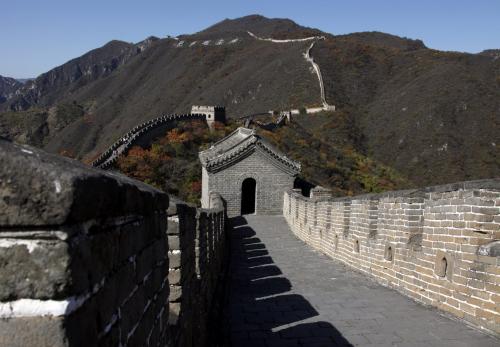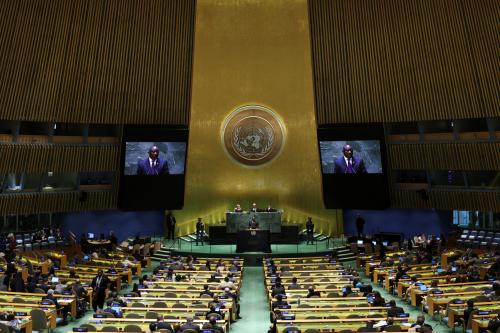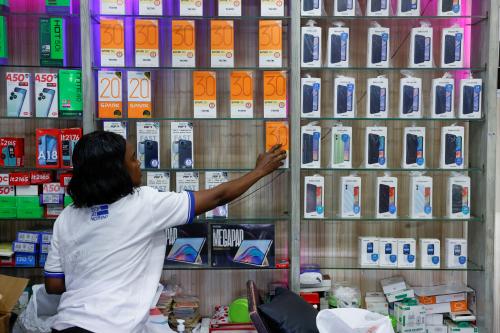The Executive Board of the International Monetary Fund (IMF) recently endorsed two updates to make its policies more accepting of the use of capital controls—steps taken by countries to limit the flow of foreign capital into and out of their economies. We argue that although the updates went in the right direction, IMF policies should go further, to be consistent with the spirit of the institution’s Articles of Agreement, which envisage a fairly ‘hands off’ attitude to the use of capital controls, as well as with best practices derived from economic research. The IMF places too many restrictions on the use of capital controls, unduly constraining the policy space of countries.
The IMF’s updated policy on capital controls
The IMF highlighted two changes to its policies. First, it allowed for capital controls to be used preemptively in some circumstances—that is, even if a country is not currently experiencing a surge of foreign capital. Its previous policy had been that such controls should only be used once a country was facing an inflow surge and even then as a measure of last resort. The updated policy takes a step in the direction of giving a country more freedom in the use of capital controls in limited circumstances, for example when there is a currency mismatch in its stock of assets and liabilities. Second, the IMF said that it wouldn’t pass judgment on certain capital controls, notably those introduced for national or international security reasons.
Why do the IMF’s views on capital controls matter? To help the IMF fulfill its mission to safeguard the stability of the international monetary system, member countries submit to annual ‘surveillance’ (monitoring) of their policies by the IMF. Although countries can and do adopt policies to pursue their national goals, international norms tend to keep countries from deviating too far from the IMF’s policy advice. Official agencies and international investors generally urge adherence to IMF advice, and countries worry that deviations from this advice may make it more difficult for them to obtain credit from abroad, which is particularly concerning for developing and emerging market economies that depend on external funding.
The IMF places too many restrictions on the use of capital controls, unduly constraining the policy space of countries.
As a result, most developing and emerging economies generally seek to follow the IMF’s policies on capital flows and work hard not to be labeled as being in violation. For instance, Korea and the IMF tussled in 2015-19 over measures the Korean authorities argued were taken to protect financial stability but the IMF labelled as capital controls—Korean officials protested that the measures were not aimed at limiting capital flows and Korea remained a very open economy. Canada was unhappy when during 2017-19 the IMF disapproved of the use of measures by some of its provincial (sub-national) governments to keep foreign capital from raising house prices in their cities; similar issues arose in the IMF’s discussions with Australia, Hong Kong, New Zealand, and Singapore.
By signaling increased comfort with capital controls, the IMF’s updated policy goes in the direction of reducing such disagreements with countries. While welcome, the revisions fall short of what is needed to allow countries to fulfil national objectives without engendering negative cross-border spillovers and by that token seem at odds with the spirit of the IMF’s Articles of Agreement.
A slow evolution
The IMF’s intellectual founders, John Maynard Keynes and Harry Dexter White, considered international capital mobility a major potential source of financial instability. The IMF’s 1944 Articles of Agreement thus gave countries wide latitude for the use of capital controls except when used to depreciate the exchange rate to gain competitive advantage (and, in doing so, contributing to negative cross-border spillovers).
This largely remained the institution’s view for five decades—the IMF was a proselytizer for free trade (it considered tariffs a sin) but not for free flows of capital. However, over this period, the major advanced economies opened up to foreign capital, starting with the United States in the 1970s and then the other members of the ‘rich countries club,’ the Organization for Economic Cooperation and Development (OECD).
With the fall of the Berlin Wall—amidst the euphoria about the triumph of free-market capitalism—there was a view that developing economies should also open their economies to free flows of foreign capital. At the urging of the U.S. Treasury, the IMF signed on to this cause. At the annual meeting of its shareholders in Hong Kong in 1997, the IMF even proposed to amend the Articles of Agreement to allow it to monitor the progress of its member countries along the path to ‘full capital account liberalization,’ a goal the institution felt should be pursued by all countries.
The IMF push came at an awkward time. Several Asian economies were in crisis after experiencing sudden stops in foreign capital flows that followed a large boom after they had liberalized capital markets in the early 1990s. The lesson those countries drew was that free flows of capital result in limited benefits but greater instability, a perspective since confirmed by IMF and academic research. The affected countries felt that they needed a flexible policy toolkit, including potentially capital controls, to tame volatile capital flows.
The IMF withdrew the proposed amendment to its Articles and instead began a process of reconsidering its views on how countries could best manage volatile capital flows. By the time of the onset of the Global Financial Crisis (GFC), the IMF took a sanguine view of the capital controls being put in place by some emerging economies as they again faced surging (a ‘tsunami’ in the words of one vocal finance minister) capital inflows from advanced economies.
After the GFC, the IMF adopted an ‘Institutional View’ (IV) on the use of capital controls, which one of us co-led. The IV stated that “there is no presumption that full [capital account] liberalization is an appropriate goal for all countries at all times,” and it provided guarded blessing for the use of capital controls to manage capital flow volatility, noting that they could be used when other means of adjustment had been exhausted or were not available.
More to do
The recent update goes a step further in endorsing (or at least not proscribing) the use of capital controls—particularly their preemptive use—based on the IMF’s analytical work and drawing on the lessons from country experience summarized in a 2020 evaluation of IMF advice on capital controls conducted by the IMF’s Independent Evaluation Office (IEO), which one of us led and to which one of us contributed an analytic background paper.
While welcome, the update leaves major issues unaddressed. The main shortcoming is that the IMF is still reluctant to allow governments to use capital controls in pursuit of domestic objectives, even when doing so does not result in a beggar-thy-neighbor competitive depreciation of exchange rates or negative financial spillovers (the main areas on which the IMF is traditionally called upon to speak). While the IMF did give a carve-out for the use of controls for national security, it still restricts their use for other domestic objectives such as social and distributional goals.
Capital account liberalization has been shown to raise various measures of inequality such as the share of income going to the top. One reason is often that many developing economies have low levels of financial inclusion, so that inflows of foreign capital end up benefitting those with strong connections to the financial system, generally the rich. Another is that inflows may push up real estate prices and make housing unaffordable for the middle class. Moreover, capital market liberalization is also associated with greater financial instability. Capital controls, of course, are not the only way to manage these challenges and may not be the best way depending on specific country circumstances. But the IMF’s remit is not to comment on all aspects of domestic economic policy. Instead, it should be guided by the vision of its founding fathers, and stick to areas enshrined in its Articles, mainly related to policies that result in a beggar-thy-neighbor cross-border spillover.
There are two other issues on which we think the recent update fails to make progress. First, the IMF’s advice is almost completely targeted at ‘recipient’ countries—countries facing capital inflows and consequent threat of reversal, but a more balanced assessment that includes the role of ‘source’ countries would have been beneficial. In many cases, the problem originates in the behavior of institutional investors in source countries rather than policy choices in recipient countries. In addition, source countries may be better positioned to assist in the regulation of capital flows, especially when recipient countries have imperfect instruments to deal with inflows. This issue seems to have fallen off the IMF’s radar, perhaps because the source countries are generally the institution’s largest shareholders who have little patience for advice from the IMF. Still, the IMF’s guidance on how to establish mechanisms of cooperation, for example along the lines of the reciprocity clauses in Basel III that facilitate countries’ cooperation on macroprudential regulation, would be very useful.
Second, the IMF left for future discussion whether the preemptive use of controls on capital outflows is justified. The IMF’s current view only blesses the use of such controls when countries are in the throes of a crisis. But countries may prefer to use such controls preemptively before foreign capital has already fled the country. The case studies for the 2020 IEO evaluation found IMF advice in such situations could have been more nimble. For instance, India and China complained of lack of timely IMF endorsement for a package of measures that included some outflow controls when the countries faced major financial pressures in 2013 and 2015, respectively. Chinese officials feel that their use of capital controls prevented adverse financial spillovers to the global economy. At the same time, Argentina’s relaxation of outflow controls in 2015, which allowed a massive outflow of funds within months, did not draw much comment from the IMF and has contributed to that country’s current difficulties.
To sum up, the update of the ‘Institutional View’ is a welcome indication of the IMF’s increasing comfort with the use of capital controls. But it still leaves the institution too often in the position of proscribing controls when these cause no material harm to global financial stability, the IMF’s remit.
During much of the 2010s, the global economic environment was benign with low global interest rates and few major global shocks. Many developing and emerging economies were reluctant to employ capital controls and accumulated significant external liabilities. Over the past two years, the COVID-19 shock increased the public debt of many countries. More recently, oil and domestic food prices have spiked, interest rates have started to creep up, and some countries face the risk of debt defaults. All these factors may lead to further capital flow volatility and the need for controls and may make countries regret the hands-off approach to international capital flows that many have followed over the past decade. It is urgent for the IMF to revise its views further and return more closely to the vision articulated in its Articles of Agreement to give countries the flexibility and policy space they need.
Anton Korinek is a Rubenstein Fellow at Brookings and a Professor of Economics and Business Administration at the University of Virginia as well as a Research Associate at the NBER. He has contributed to the debate on capital controls as an academic and has consulted the IMF on the topic, most recently as a contributor to the 2020 IMF Independent Evaluation Office (IEO) evaluation of IMF Advice on Capital Flows.
Prakash Loungani is Assistant Director in the IMF’s Independent Evaluation Office (IEO) and an adjunct professor at Johns Hopkins University. He led the 2020 IEO evaluation of IMF Advice on Capital Flows.
Jonathan D. Ostry is Distinguished Scholar and, effective August 2022, Professor of the Practice in the Department of Economics at Georgetown University. He led the analytical work at the IMF underpinning the Institutional View on capital flows as Deputy Director of the Research Department and has continued to be involved in the review of the Institutional View in recent years, including as the IMF’s Acting Director for the Asia Pacific region.
The Brookings Institution is financed through the support of a diverse array of foundations, corporations, governments, individuals, as well as an endowment. A list of donors can be found in our annual reports published online here. The findings, interpretations, and conclusions in this report are solely those of its author(s) and are not influenced by any donation.
The Brookings Institution is committed to quality, independence, and impact.
We are supported by a diverse array of funders. In line with our values and policies, each Brookings publication represents the sole views of its author(s).






Commentary
The IMF’s updated view on capital controls: Welcome fixes but major rethinking is still needed
April 18, 2022